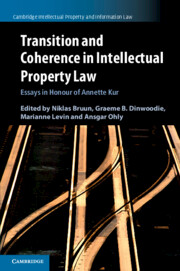Book contents
- Transition and Coherence in Intellectual Property Law
- Cambridge Intellectual Property and Information Law
- Transition and Coherence in Intellectual Property Law
- Copyright page
- Contents
- Preface
- Greetings to Annette Kur from the Second Floor
- Annette Kur: Toward Understanding
- Part I Transition
- A Forms and Institutions
- B International Commitments and Constraints
- C New Agents and the Challenge of New Technologies
- 12 Transition through Automation
- 13 Eye, Robot: Artificial Intelligence and Trade Mark Registers
- 14 Patent Protection of Inventions Involving Artificial Intelligence
- 15 Automated Profiling in New Media and Entertainment Markets: What to Protect, and How?
- Part II Coherence
- Conclusion
- Cambridge Intellectual Property and Information Law
12 - Transition through Automation
from C - New Agents and the Challenge of New Technologies
Published online by Cambridge University Press: 29 December 2020
- Transition and Coherence in Intellectual Property Law
- Cambridge Intellectual Property and Information Law
- Transition and Coherence in Intellectual Property Law
- Copyright page
- Contents
- Preface
- Greetings to Annette Kur from the Second Floor
- Annette Kur: Toward Understanding
- Part I Transition
- A Forms and Institutions
- B International Commitments and Constraints
- C New Agents and the Challenge of New Technologies
- 12 Transition through Automation
- 13 Eye, Robot: Artificial Intelligence and Trade Mark Registers
- 14 Patent Protection of Inventions Involving Artificial Intelligence
- 15 Automated Profiling in New Media and Entertainment Markets: What to Protect, and How?
- Part II Coherence
- Conclusion
- Cambridge Intellectual Property and Information Law
Summary
Quite fitting with one of the themes for this book, the first major project on which I had the privilege to work with Annette Kur was called ‘Intellectual Property Rights in Transition’ (IPR in Transition); its outcome was subsequently published as Intellectual Property Rights in a Fair World Trade System: Proposals for Reform of TRIPS (EE Publishing, 2011). Based on our earlier discussions about key shortcomings within the international IP system, Annette and I focused on the concept of ceilings: the idea was to challenge the commonly held view that international IP law is only about setting minimum standards and can be further expanded without limits (or ceilings).2 While I am not sure what role our work played in this, a range of subsequent developments in international IP law show a transition to a system where IP treaties are not only about guaranteeing exclusive rights and other protections,3 and where IP protection is conceptualized as an element within a broader set of international norms that can counter attempts for limitless expansions of IP protection and enforcement.4
- Type
- Chapter
- Information
- Transition and Coherence in Intellectual Property LawEssays in Honour of Annette Kur, pp. 157 - 173Publisher: Cambridge University PressPrint publication year: 2021

